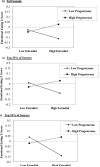The interactive effects of estrogen and progesterone on changes in emotional eating across the menstrual cycle
- PMID: 22889242
- PMCID: PMC3570621
- DOI: 10.1037/a0029524
The interactive effects of estrogen and progesterone on changes in emotional eating across the menstrual cycle
Erratum in
- J Abnorm Psychol. 2013 Feb;122(1):137. Burt, Alexandra S [corrected to Burt, S Alexandra]
Abstract
Studies suggest that within-person changes in estrogen and progesterone predict changes in binge eating across the menstrual cycle. However, samples have been extremely small (maximum N = 9), and analyses have not examined the interactive effects of hormones that are critical for changes in food intake in animals. The aims of the current study were to examine ovarian hormone interactions in the prediction of within-subject changes in emotional eating in the largest sample of women to date (N = 196). Participants provided daily ratings of emotional eating and saliva samples for hormone measurement for 45 consecutive days. Results confirmed that changes in ovarian hormones predict changes in emotional eating across the menstrual cycle, with a significant estradiol × progesterone interaction. Emotional eating scores were highest during the midluteal phase, when progesterone peaks and estradiol demonstrates a secondary peak. Findings extend previous work by highlighting significant interactions between estrogen and progesterone that explain midluteal increases in emotional eating. Future work should explore mechanisms (e.g., gene-hormone interactions) that contribute to both within- and between-subjects differences in emotional eating.
2013 APA, all rights reserved
Figures


Similar articles
-
Individual differences in the relationship between ovarian hormones and emotional eating across the menstrual cycle: a role for personality?Eat Behav. 2013 Apr;14(2):161-6. doi: 10.1016/j.eatbeh.2013.02.007. Epub 2013 Feb 26. Eat Behav. 2013. PMID: 23557813 Free PMC article.
-
The effects of ovarian hormones and emotional eating on changes in weight preoccupation across the menstrual cycle.Int J Eat Disord. 2015 Jul;48(5):477-86. doi: 10.1002/eat.22326. Epub 2014 Jun 26. Int J Eat Disord. 2015. PMID: 24965609 Free PMC article.
-
Associations between ovarian hormones and emotional eating across the menstrual cycle: Do ovulatory shifts in hormones matter?Int J Eat Disord. 2019 Feb;52(2):195-199. doi: 10.1002/eat.22985. Epub 2019 Jan 15. Int J Eat Disord. 2019. PMID: 30648266 Free PMC article.
-
Stress as a potential moderator of ovarian hormone influences on binge eating in women.F1000Res. 2019 Feb 27;8:F1000 Faculty Rev-222. doi: 10.12688/f1000research.16895.1. eCollection 2019. F1000Res. 2019. PMID: 30854192 Free PMC article. Review.
-
The effect of the menstrual cycle on exercise metabolism: implications for exercise performance in eumenorrhoeic women.Sports Med. 2010 Mar 1;40(3):207-27. doi: 10.2165/11317090-000000000-00000. Sports Med. 2010. PMID: 20199120 Review.
Cited by
-
Stress and addiction.Psychoneuroendocrinology. 2013 Sep;38(9):1923-7. doi: 10.1016/j.psyneuen.2013.06.017. Epub 2013 Jul 9. Psychoneuroendocrinology. 2013. PMID: 23849597 Free PMC article. Review.
-
Individual differences in the relationship between ovarian hormones and emotional eating across the menstrual cycle: a role for personality?Eat Behav. 2013 Apr;14(2):161-6. doi: 10.1016/j.eatbeh.2013.02.007. Epub 2013 Feb 26. Eat Behav. 2013. PMID: 23557813 Free PMC article.
-
Is It Worth It? Obesity Affects Snack Food Valuation Across the Menstrual Cycle.Front Neurosci. 2022 Feb 16;16:800976. doi: 10.3389/fnins.2022.800976. eCollection 2022. Front Neurosci. 2022. PMID: 35250448 Free PMC article.
-
Eating disorders in premenstrual dysphoric disorder: a neuroendocrinological pathway to the pathogenesis and treatment of binge eating.J Eat Disord. 2018 Oct 25;6:35. doi: 10.1186/s40337-018-0222-2. eCollection 2018. J Eat Disord. 2018. PMID: 30386599 Free PMC article.
-
Managing the premenstrual body: a body mapping study of women's negotiation of premenstrual food cravings and exercise.J Eat Disord. 2021 Oct 9;9(1):125. doi: 10.1186/s40337-021-00478-6. J Eat Disord. 2021. PMID: 34627402 Free PMC article.
References
-
- Buffenstein R, Poppitt SD, McDevitt RM, Prentice AM. Food intake and the menstrual cycle: A retrospective analysis, with implications for appetite research. Physiology and Behavior. 1995;58(6):1067–1077. - PubMed
-
- Bulik CM. Eating disorders in adolescents and young adults. Child and Adolescent Psychiatric Clinics. 2002;11:201–218. - PubMed
Publication types
MeSH terms
Substances
Grants and funding
LinkOut - more resources
Full Text Sources
Other Literature Sources

